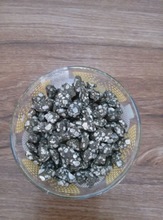Natural Rough Barite Ore for Chemical Industry??
Introduction
?
Barite is a mineral that comprises barium sulfate (BaSO4). It is usually colorless or milky white, but can be almost any color, depending on the impurities trapped in the crystals during their formation. Barite is relatively soft, measuring measures only 3 to 3.5 on the Moh's scale of hardness. Despite its softness, it is unusually heavy for a nonmetallic mineral. The high density is responsible for its value in many applications.
Uses
?
By far, the principal use for barite is as a "weighting agent" in oil and natural gas drilling. In this process, barite is crushed and mixed with water and other materials. It is then pumped into the drill hole. The weight of this mixture counteracts the force of the oil and gas when it is released from the ground. This allows the oil and gas rig operators to prevent the explosive release of the oil and gas from the ground. Currently, the majority of barite consumption in the United States is for this drilling application. However, the consumption in drilling "mud" fluctuates from year to year, as it is dependent on the amount of exploration drilling for oil and gas, which in turn depends on oil and gas prices.
?
?
Specifications:
?
Certificate of Analysis | |
Appearance | White powder |
BaSO4 | 95% min |
Density | 4.30g/ml min |
Whiteness | 95%min |
Carbonates | 0.70% |
Water soluble alkaline | 24 mg/kg |
Moisture | 0.02% |
Fe2o3 | 0.18% |
Sio2 | 0.66% |
Al2o3 | 0.04% |
Water Solubles | 0.03% |
Residue greater than 75 um | 0.97% |
Particle less than 6 um | 24.20% |
?
??
????? ???????
?
























 在線聊天
在線聊天


























